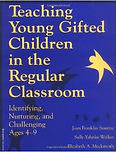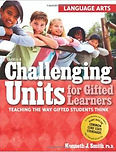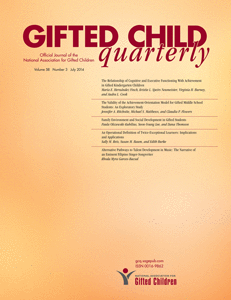We love reading!
Resource for
all Readers
Resources and Materials for Teachers
Books for Teachers of Gifted Students of All Ages
Using the Common Core State Standards for English Language Arts With Gifted and Advanced Learners, Joyce VanTassel-Baska Ed.D. (2012)
This text provides teachers and administrators examples and strategies to implement the new Common Core State Standards (CCSS) with advanced learners at all stages of development in K–12 schools. The book describes—and demonstrates with specific examples from the CCSS—what effective differentiated activities in English language arts look like for top learners. It shares how educators can provide both rigor and relevance within the new standards as they translate them into meaningful experiences for gifted and advanced learners.
A Teacher's Guide to Using the Common Core State Standards With Gifted and Advanced Learners in the English/Language Arts, Joyce VanTassel-Baska Ed.D., Claire Hughes Ph.D., Elizabeth Shaunessy-Dedrick Ph.D., Todd Kettler (2013)
This text provides teachers and administrators a blueprint for differentiating the Common Core State Standards for English Language Arts for gifted and advanced students through the use of acceleration, depth, complexity, and creativity within and across grade levels. It illustrates the differences between learning experiences for typical and advanced students based on the same standard and provides an array of examples across five of the information text and literary text standards while integrating the other aspects of language arts teaching and learning. The book highlights implementation features, such as classroom management and assessment of student work, that allow teachers to make data-based decisions about instruction for particular students. It also offers guidance to teachers on reading selections for advanced learners at all grade levels.
The Cluster Grouping Handbook: A School-wide Model: How to Challenge Gifted Students and Improvement Achievement for All, Susan Winebrenner and Dina Brulles (2008)
This text explains how the School-wide Cluster Grouping Model (SCGM) differs from grouping practices of the past, and presents a roadmap for implementing, sustaining, and evaluating school-wide cluster grouping. Practitioners will find a wealth of teacher-tested classroom strategies along with detailed information on identifying students for clusters, gaining support from parents, and providing ongoing professional development. Digital content features customizable reproducible forms and a PowerPoint presentation designed for in-service training.
Teaching Gifted Kids in the Regular Classroom: Strategies and Techniques Every Teacher Can Use to Meet the Academic Needs of the Gifted and Talented, Sylvia B. Rimm and Susan Winebrenner (2001)
Teachers refer to it as the “orange Bible.” Since the first edition was published, author Susan Winebrenner has spent eight years using it with school districts, teachers, parents, and kids across the U.S. and the U.K. This revised, expanded, updated edition reflects her personal experiences and the changes that have taken place in education over the years. The step-by-step how-tos for using the strategies are more detailed and user-friendly. All of the forms in the book are also on CD-ROM (sold separately) so you can print them out and customize them for your classroom.
The Differentiated Classroom: Responding to the Needs of All Learners, 2nd Edition, Carol Ann Tomlinson (2014)
In this updated second edition of her best-selling classic work, Carol Ann Tomlinson offers teachers a powerful and practical way to meet a challenge that is both very modern and completely timeless: how to divide their time, resources, and efforts to effectively instruct so many students of various backgrounds, readiness and skill levels, and interests.
With a perspective informed by advances in research and deepened by more than 15 years of implementation feedback in all types of schools, Tomlinson explains the theoretical basis of differentiated instruction, explores the variables of curriculum and learning environment, shares dozens of instructional strategies, and then goes inside elementary and secondary classrooms in nearly all subject areas to illustrate how real teachers are applying differentiation principles and strategies to respond to the needs of all learners.
For Teachers of Early Childhood Gifted Students
Books:
Teaching Young Gifted Children in the Regular Classroom: Identifying, Nurturing, and Challenging Ages 4-9, Marjorie Lisovskis, Joan Franklin Smutny, Sally Yahnke Walker, Elizabeth A. Meckstroth (1997)
Proven, practical ways to recognize and nurture young gifted children as early as age four and create a learning environment that supports all students. Helps you teach to multiple intelligences, and compact and expand the curriculum. Digital content has customizable forms from the book.
Methods and Materials for Teaching the Gifted, Frances Karnes Ph.D., Suzanne Bean Ph.D. (2008)
The newly revised and updated Methods and Materials for Teaching the Gifted offers strategies and resources for differentiating instruction for gifted learners. The book acts as an excellent introduction to gifted education curricular planning, instructional unit design, evaluation, and teaching methods.
The chapters of this comprehensive textbook are written by respected leaders in the field of gifted education. The authors review the needs of gifted learners, instructional planning and evaluation, strategies for best practices, and ongoing enhancement and support of gifted programs. Chapters include topics such as differentiated curricular design, extending learning through mentorships, building challenging instructional units, and developing creative thinking. Also, instructional practices, such as problem-based learning, independent study, classroom simulations, and more are addressed.
The third edition includes a brand-new chapter on educational technology for the gifted, as well as updated information on books, teaching materials, Web sites, and other resources for differentiating instruction and planning gifted education curriculum.
Web-based Resources:
This site dedicated to giftedness features an At School section. Within this section, educators can find practical advice on a variety of topics, including grade acceleration, identification, equal education, teaching, inclusion, challenges, bullying, and IQ tests. Under the teaching tab, there are useful ideas about how to challenge the gifted child.
Amazing Classrooms: Engaging the High Achievers
In response to high dropout rates among high performing teenagers, educators in this school district decided to address the problem at the grade school level. This video captures their experimental cluster program designed to keep gifted and talented students engaged in learning. In a multi-grade class of fourth, fifth, and sixth graders, students learn to work and communicate in teams. Through projects and a class structure that supports differentiation, the teacher is able to keep students challenged and engaged. Her strategies for differentiation and communication can be used in any classroom.
For Teachers of Middle Childhood Gifted Students
Books:
Educating Gifted Students in Middle School, Susan Rakow Ph.D. (2011)
This newly revised and expanded second edition of Educating Gifted Students in Middle School updates the practical information about meeting these needs offered in the award-winning 2004 edition. A new chapter on the STEM (science, technology, engineering, and math) areas as well as a completely revised chapter on English/language arts for gifted and advanced learners in the middle grades are key components of the new edition. The impact of current reform movements, response to Intervention, new relevant research, updated information on middle school boys and other special populations, changing middle grade configurations, and 21st-century skills are added to the already thorough discussions of the first edition.
Challenging Units for Gifted Learners: Language Arts: Teaching the Way Gifted Students Think, Kenneth J. Smith (2010)
This text is designed to help teachers provide the stimulating curricula that will nurture gifted students’ potential in school. The units are based on research into how these students actually think differently from their peers and how they use their learning styles and potential not merely to develop intellectual expertise, but to move beyond expertise to the production of new ideas.
The Language Arts book includes units that ask students to develop strong personalities for their main characters while writing mysteries, study Freud's psychoanalytic theory and then analyze a classic novel using what they've learned, focus on writing from a specific point of view, and increase their appreciation for poetry by studying famous poets.
Web-based Resources:
Exquisite Minds offers support to parents and educators who want to challenge children to find new and constructive ways to look at the world. The site features sections like Idea of the Week, Best Links for Educators, Best Resources, and Best Online Brainy Games. There are all kinds of interesting tabs to stimulate creative ideas and thinking.
teachfine on gifted and ed tech
This site collects resources that combine gifted education and technology, creating a great list of articles and sites that educators, parents and kids can use to learn. Posted articles by leaders like Carol Ann Tomlinson offer strategic insights into reaching gifted learners.
For Teachers of Adolescent/Young Adult Gifted Students
Books:
Teaching Gifted Kids in Today's Classroom: Strategies and Techniques Every Teacher Can Use, Susan Winebrenner M.S. and Dina Brulles Ph.D. (2012)
Included are practical, classroom-tested strategies and step-by-step instructions for how to use them. The new edition provides information on using technology for accelerated learning, managing cluster grouping, increasing curriculum rigor, improving assessments, boosting critical and creative thinking skills, and addressing gifted kids with special needs.
Rigor and Engagement for Growing Minds: Strategies that Enable High-Ability Learners to Flourish in All Classrooms, Bertie Kingore Ph.D. (2013)
2014 Teacher's Choice Award -- The evidence- and research-based content is developed with hundreds of applications and supported with more than 250 citations and helpful websites. Current research and the Common Core (CCSS) move the focus of education from mastering content toward a major concern for rigor, relevance, depth, clarity, and understanding how instruction influences all students' continuous learning and future life in college or the work place. Explore hundreds of ready-to-use ideas and learning experiences to realistically help you transform your classroom into a rigorous learning environment. Implement the CCSS while lifting standards for high-ability students.
Differentiating Content for Gifted Learners in Grades 6-12 (Multimedia CD), Susan Winebrenner M.S. (2005)
This stand-alone CD-ROM includes more than 140 reproducible forms and templates, plus detailed explanations on how to differentiate content for gifted and high-ability learners in secondary settings.
Web-based Resources:
Educational Resources for Parents and Teachers of Gifted Youth
Mensa is a great place to look for help with a gifted child. Here, they offer up a collection of resources for parents and teachers that range from lesson places to fun activities.
Gifted Child Quarterly (GCQ) publishes original research and new and creative insights about giftedness and talent development in the context of the school, the home, and the wider society. Each issue offers quantitative and qualitative research studies that explore the characteristics of gifted students, program models, curriculum and other important areas that maximize the development and education of gifted students.
National Support Organizations
National Association for Gifted Children
The National Association for Gifted Children is one of the best places for educators and parents of gifted children to find resources, reading, help, and advice on exceptional children. There are multiple resources for educators, both in print and online. In the Education and Training section, webinars and events are listed.
American Association for Gifted Children
The American Association for Gifted Children (AAGC) is the nation's oldest advocacy organization for gifted children. Throughout its history, AAGC has published materials for the educational research community, for people in the medical profession, and for parents and teachers of gifted children.
The Gifted Child Society is a nonprofit organization dedicated to furthering the cause of gifted children. Through their website, educators can find helpful information and learn through articles, links, and events about how best to serve the needs of gifted children.
Blogs
Carol Bainbridge, an expert on gifted children, maintains this blog, which is full of learning ideas, information, and more.
This blog focuses on gifted kids, touching on issues of schooling, parenting, education, and more, all written by the staff at the Davidson Institute for Talent Development.
Prufrock is one of the leading publishers of materials for gifted, advanced, and special needs students. On this blog, you’ll find updates on their latest releases.
Head to this Education Week blog to hear from Tamara Fisher, a K-12 gifted education specialist. She gives great insights into gifted and talented education.
Focusing on creativity, accelerated learning, literature, and more, this blog offers resources and inspiration to gifted educators and parents of gifted kids. There is a language arts section with ideas about how to differentiate compare and contrast, improving inferences, and more.


















Last updated July 25, 2014